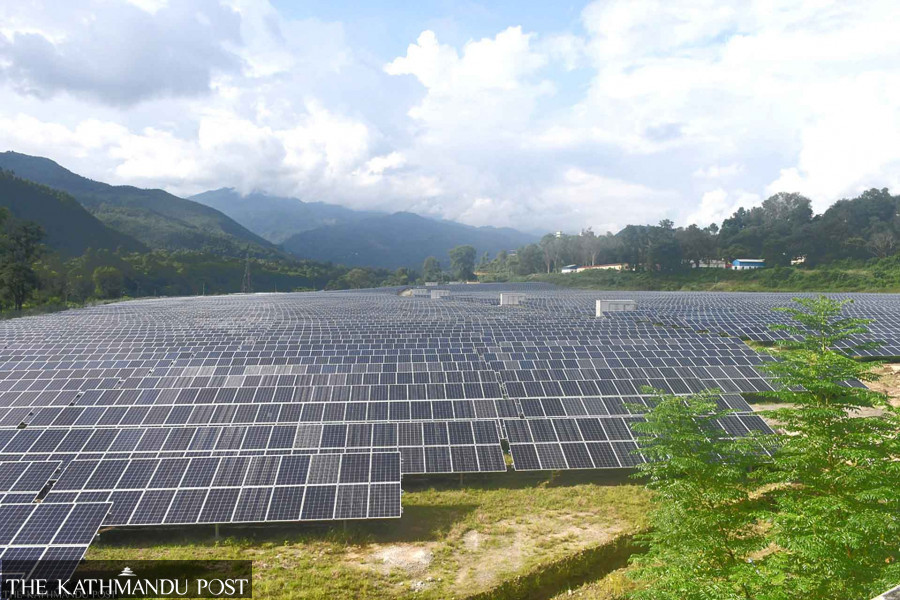Columns
Nepal’s overlooked solar potential
We must embrace solar power as a strategic energy resource to secure a sustainable, resilient future.
Atul K Thakur & Deepak Rauniar
Nepal’s electricity crisis is once again making headlines. While the Nepal Electricity Authority (NEA) and the energy ministry continue to offer differing perspectives on the issue, they converge on one undeniable fact: Nepal is facing an electricity shortage.
The immediate victims of this crisis are Nepal’s industries, as the NEA prioritises residential consumers over industrial demand during power shortages. This is paradoxical in today’s global landscape, where countries including India are prioritising domestic industries to reduce reliance on imports by boosting local production. The indirect victim, however, is Nepal’s reputation as a reliable electricity supplier to its neighbours. At a time when Nepal should be accelerating energy development to expand electricity exports to India, the government’s repeated requests to increase exports highlight a stark contradiction—Nepal is struggling to meet its own energy needs while simultaneously seeking to sell power abroad.
However, there is still time to correct this trajectory. Nepal can address domestic power shortages and strengthen its position as a reliable energy provider in the region by strategically harnessing solar energy.
Missed potential of solar energy
For decades, Nepal has focused almost exclusively on hydropower development to meet its energy needs. Until recently, this strategy was logical. However, given the rapid advancements in solar energy technology, Nepal’s continued disregard for commercial solar power is a glaring misstep. Hydropower remains a valuable resource, but its development is time-consuming, capital-intensive and fraught with environmental and logistical challenges. In contrast, solar energy is a complementary solution that can be rapidly deployed and is increasingly cost-effective due to technological advancements and global supply chains.
Nepal’s solar potential is immense. Estimates suggest the country can generate up to 50,000 terawatt-hours (TWh) of solar energy annually, which is approximately 7,000 times more than its current electricity consumption. These figures may appear imaginative, but in fact, Nepal is falling short of exploiting the basic potential of solar capacity. Despite this vast potential, the country’s installed solar capacity remains around 55 megawatts (MW), contributing just over 1 percent to the nation’s total electricity output. In Nepal, the silver lining is the growing collective urge to adopt renewable energy sources, including solar energy. However, the structural inefficiency to usher in a transformative transition towards increased contribution of solar in total energy output remains a bottleneck.
Regional developments and opportunities
Nepal’s reluctance to embrace solar energy contrasts with India’s aggressive expansion in this sector. India has emerged as a global leader in solar energy, with an installed capacity exceeding 73 gigawatts (GW) as of 2024 and an ambitious target of reaching 280 GW by 2030. Through an institutional initiative like the International Solar Alliance (ISA) and a series of constructive policy measures/industrial incentives for the use of renewable energy, India is not only reducing its reliance on fossil fuels but also positioning itself as a hub for solar technology and expertise. Such a major shift has yielded significant economic benefits, including reduced energy costs, enhanced energy security and job creation. Additionally, India’s commitment to clean energy has bolstered its global standing, attracting foreign investments and technological collaborations.
Nepal, which has a strong bilateral relationship with India, benefits immensely from India’s transition to renewable energy. With India committing to import 10,000 MW of electricity from Nepal over the next decade, Nepal must expand and diversify its energy sources to fully capitalise on this opportunity, besides keeping the growth momentum for its hydroelectricity.
Solar energy integration
Integrating solar energy into Nepal’s energy mix offers several strategic benefits, such as diversification and reliability, improving energy security and grid stability. This will in turn reduce Nepal’s over-reliance on hydropower, which is vulnerable to seasonal variations and climate change impacts.
The deployment of solar projects can be implemented faster than large-scale hydropower plants. This makes it an ideal solution for addressing immediate energy shortages. Regarding economic growth, investing in solar energy can create jobs in manufacturing, installation and maintenance, driving economic activity in urban and rural areas. Developing domestic solar capacity can help Nepal achieve energy independence and enhance national energy security. Further, the cost of solar power has plummeted globally, making it a highly affordable energy solution. Nepal must capitalise on this trend before it falls further behind.
Policy gaps and recommendations
Despite the clear advantages, Nepal’s policy framework for solar energy remains weak. The lack of proactive strategies has resulted in missed opportunities and a continued reliance on hydropower-centric energy planning. To address this, Nepal must develop favourable policies, such as implementing policies that encourage investment in large-scale commercial solar energy, including tax incentives and regulatory support. Another prerequisite for effective implementation is establishing competitive pricing by setting attractive feed-in tariffs and ensuring fair power purchase agreements (PPAs) to make solar investments financially viable.
For Nepal, infrastructural development is crucial. We must modernise the national grid to support solar energy integration and invest in energy storage solutions to manage supply fluctuations. Private sector participation has to be encouraged wherever it is needed besides removing bureaucratic hurdles and incentivising investments in solar energy projects. To reduce costs and enhance efficiency, supporting local innovation in solar panel production, installation and battery storage technologies is a must.
Nepal’s continued oversight of commercial solar energy is becoming expensive. As the country struggles with electricity shortages, its over-reliance on hydropower alone is proving insufficient to meet growing domestic and export demands. By harnessing its abundant solar potential, Nepal can not only alleviate power shortages but also strengthen its economic and energy security. At a time when the world is rapidly transitioning towards solar energy, Nepal cannot afford to lag behind. The time for action is now. Nepal must embrace solar power as a strategic energy resource to secure a sustainable, resilient and prosperous future.




 6.12°C Kathmandu
6.12°C Kathmandu
















